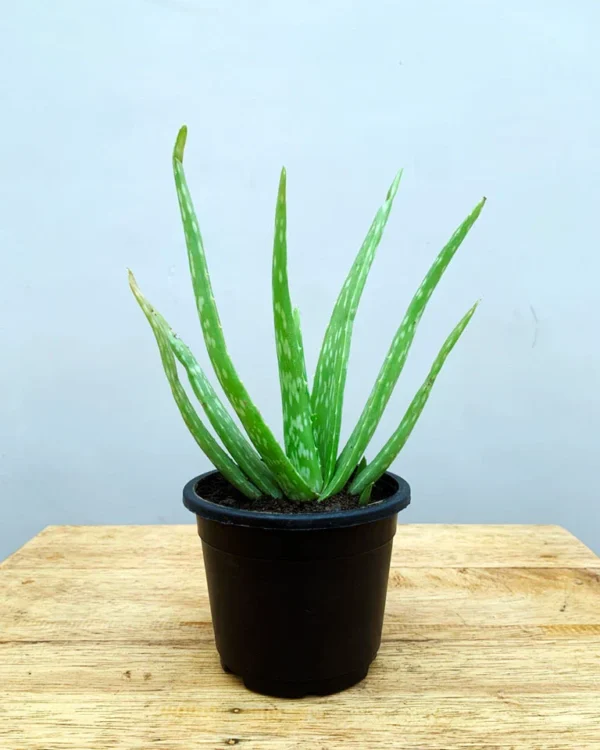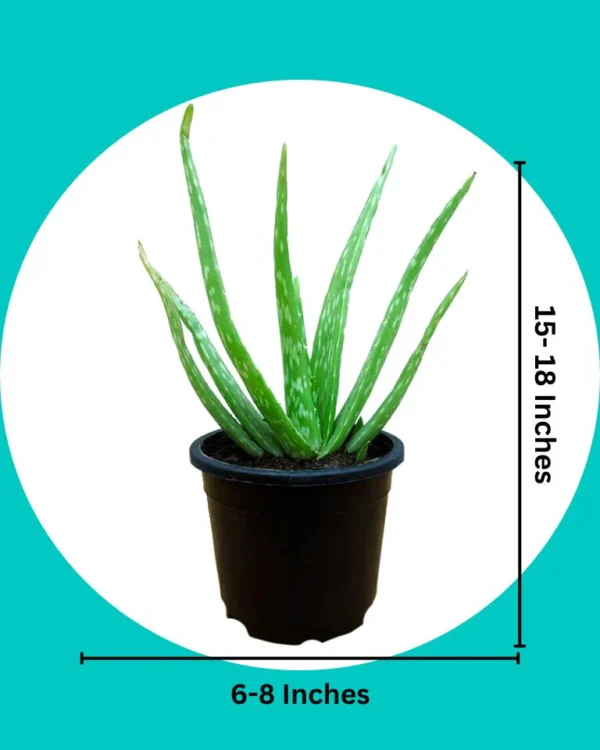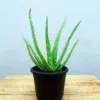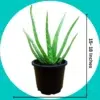Description
Caring for an aloe vera plant is relatively easy, as these succulents are hardy and adaptable. Here are some essential tips for taking care of your aloe vera plant:
- Sunlight:
- Aloe vera plants thrive in bright, indirect sunlight.
- They can tolerate some direct sunlight, but prolonged exposure to intense sunlight may lead to sunburn.
- Temperature:
- Aloe vera prefers temperatures between 59°F (15°C) and 77°F (25°C).
- It can tolerate slightly cooler temperatures but should be protected from frost.
- Watering:
- Aloe vera is a succulent and is adapted to arid conditions. It’s important not to overwater.
- Water the plant thoroughly but allow the soil to dry out between waterings.
- Water sparingly during the winter months.
- Soil:
- A well-draining soil mix is crucial for aloe vera.
- Use a cactus or succulent potting mix or add perlite or sand to regular potting soil to improve drainage.
- Container:
- Use a pot with drainage holes to prevent water from accumulating at the bottom.
- Aloe vera prefers a slightly crowded root system, so choose a pot that is not too large.
- Fertilization:
- Aloe vera does not require frequent fertilization.
- Use a balanced, diluted fertilizer during the growing season (spring and summer) every 4-6 weeks.
- Pruning:
- Trim off any dead or damaged leaves at the base of the plant using clean, sharp scissors or pruning shears.
- Regular pruning can help maintain a tidy appearance.
- Pests:
- Aloe vera is generally resistant to pests, but occasionally, you may encounter issues like aphids or mealybugs.
- Inspect the plant regularly, and if pests are present, treat them with insecticidal soap or neem oil.
- Repotting:
- Repot aloe vera plants every 2-3 years or when the plant becomes root-bound.
- Choose a slightly larger pot and refresh the soil during repotting.
- Propagation:
- Aloe vera can be propagated by separating offsets (pups) that grow at the base of mature plants.
- Allow the offsets to dry for a day before planting them in a new pot.
- Indoor Care:
- If grown indoors, place the aloe vera near a south or west-facing window to ensure it receives adequate sunlight.
- Rotate the plant occasionally to promote even growth.
- Caution:
- Avoid overwatering, as this can lead to root rot.
- Allow the soil to dry out completely before the next watering.
- Do not let water collect in the rosette of leaves, as this can lead to fungal issues.
By following these care tips, you can help your aloe vera plant thrive and enjoy its numerous benefits. Keep in mind that aloe vera is resilient, and a little neglect is often better than over-care. Observe your plant regularly and adjust care based on its specific needs.
Other Use
Aloe vera is a succulent plant species that has been widely recognized for its medicinal and cosmetic properties. Here is a comprehensive overview of various aspects of aloe vera:
Botanical Information:
- Scientific Name: Aloe barbadensis miller is the most commonly cultivated species for its medicinal properties.
- Family: Asphodelaceae (formerly Liliaceae)
- Common Names: Aloe vera, True Aloe, Burn Aloe
Physical Characteristics:
- Appearance:
- Aloe vera plants typically have thick, fleshy green leaves.
- The leaves are lance-shaped and contain a gel-like substance.
- Growth:
- Aloe vera is a succulent that thrives in warm, arid climates.
- It is often grown as a potted plant indoors in cooler climates.
Medicinal Uses:
- Aloe Vera Gel:
- The gel inside the leaves is commonly used for various medicinal purposes.
- It is known for its anti-inflammatory, antibacterial, and antifungal properties.
- Skin Care:
- Aloe vera is used to soothe and moisturize the skin.
- It is often applied topically to treat sunburns, minor cuts, and skin irritations.
- Digestive Health:
- Aloe vera juice is consumed for its potential benefits on digestive health.
- It may help alleviate symptoms of irritable bowel syndrome (IBS) and other digestive issues.
- Wound Healing:
- Aloe vera is believed to enhance the wound healing process due to its regenerative properties.
Commercial Products:
- Aloe Vera Gel Products:
- Various skincare and cosmetic products contain aloe vera gel.
- These include lotions, creams, sunscreens, and more.
- Aloe Vera Juice:
- Aloe vera juice is available as a dietary supplement.
- It is consumed for its potential internal health benefits.
Cultivation:
- Growing Conditions:
- Aloe vera requires well-draining soil and plenty of sunlight.
- It is drought-tolerant and can thrive in dry conditions.
- Propagation:
- Aloe vera plants can be propagated from offsets or “pups” that grow at the base of mature plants.
Precautions and Considerations:
- Topical Use:
- Some individuals may be allergic to aloe vera. A patch test is recommended before widespread use.
- Internal Use:
- When consuming aloe vera internally, it is crucial to use products specifically labeled for internal use.
- Excessive consumption may lead to digestive discomfort.
Research:
- Scientific Studies:
- Research has been conducted on aloe vera’s potential benefits for wound healing, skin conditions, and digestive health.
- However, more research is needed to establish conclusive evidence for some claims.
Conclusion:
Aloe vera is a versatile plant with a long history of use in traditional medicine and modern skincare. While its gel is widely recognized for its topical applications, its internal use and other potential health benefits continue to be areas of research and exploration. As with any natural remedy, it’s essential to use aloe vera with caution and, if needed, consult with a healthcare professional, especially for internal consumption.








Reviews
There are no reviews yet.